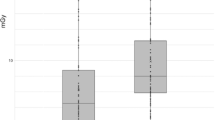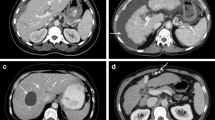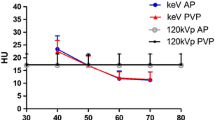Abstract
Objective
To investigate the image quality and radiation dose of dual-energy computed tomography (DECT) with automatic spectral imaging protocol selection (ASIS) compared with those of low-kVp CT in abdominal multiphase CT.
Methods
Four groups of 60 patients each underwent abdominal scans with low-kVp CT (A, 80 kVp/300 mg I/kg, body mass index [BMI] ≤ 23.9 kg/m2; C, 100 kVp/400 mg I/kg, BMI ranging from 24 to 28.9 kg/m2) or DECT with ASIS, and the 40- to 60-keV virtual monochromatic images (VMIs) generated (B and D) were matched by age, gender, BMI, cross-sectional area, and contrast agent dose; 9 patients were excluded due to technical failures. The CT number, image noise, contrast-to-noise ratio, and subjective image quality were compared between the matched protocols (A and B or C and D) on 1.25-mm reconstructed images.
Results
VMIs at approximately 55 keV and 62 keV had CT numbers and contrast similar to those of 80-kVp and 100-kVp CT images, respectively. Compared to matched low-kVp images, VMIs at 50 keV provided a higher CT number and image noise and a similar or higher contrast and overall image quality. The radiation dose for DECT was higher than that of 80-kVp CT (increased by 10%), but was similar to that of 100-kVp CT.
Conclusion
Compared to matched low-kVp CT, VMIs at 50 keV in DECT with ASIS provided similar or higher overall image quality, with no or minimal dose penalty in small- and medium-sized patients.
Key Points
• Virtual monochromatic images at approximately 55 keV and 62 keV have CT numbers and contrast similar to those of 80-kVp and 100-kVp CT images, respectively, with a given noise index.
• The radiation dose in dual-energy CT with automatic spectral imaging protocol selection was slightly higher than that of 80-kVp CT (increased by 10%) but was similar to that of 100-kVp CT.
• Dual-energy CT may be able to replace l00-kVp CT for routine clinical abdominal contrast-enhanced CT scans.





Similar content being viewed by others
Abbreviations
- AP:
-
Arterial phase
- ASIR:
-
Adaptive statistical iterative reconstruction
- ASIS:
-
Automatic spectral imaging protocol selection
- CNR:
-
Contrast-to-noise ratio
- CTDIvol:
-
Volume computed tomography dose index
- IC:
-
Iodine concentration
- keV:
-
Kiloelectron volt
- kVp:
-
Peak kilovoltage
- PVP:
-
Portal venous phase
- VMI:
-
Virtual monochromatic images
References
Lee KH, Lee JM, Moon SK et al (2012) Attenuation-based automatic tube voltage selection and tube current modulation for dose reduction at contrast-enhanced liver CT. Radiology 265:437–447
Marin D, Nelson RC, Schindera ST et al (2010) Low-tube-voltage, high-tube-current multidetector abdominal CT: improved image quality and decreased radiation dose with adaptive statistical iterative reconstruction algorithm--initial clinical experience. Radiology 254:145–153
Marin D, Nelson RC, Samei E et al (2009) Hypervascular liver tumors: low tube voltage, high tube current multidetector CT during late hepatic arterial phase for detection--initial clinical experience. Radiology 251:771–779
Schindera ST, Diedrichsen L, Müller HC et al (2011) Iterative reconstruction algorithm for abdominal multidetector CT at different tube voltages: assessment of diagnostic accuracy, image quality, and radiation dose in a phantom study. Radiology 260:454–462
Marin D, Nelson RC, Barnhart H et al (2010) Detection of pancreatic tumors, image quality, and radiation dose during the pancreatic parenchymal phase: effect of a low-tube-voltage, high-tube-current CT technique--preliminary results. Radiology 256:450–459
Lv P, Lin XZ, Chen K, Gao J (2012) Spectral CT in patients with small HCC: investigation of image quality and diagnostic accuracy. Eur Radiol 22:2117–2124
Noda Y, Kanematsu M, Goshima S et al (2015) Reducing iodine load in hepatic CT for patients with chronic liver disease with a combination of low-tube-voltage and adaptive statistical iterative reconstruction. Eur J Radiol l84:11–18
Yamada Y, Jinzaki M, Hosokawa T, Tanami Y, Abe T, Kuribayashi S (2014) Abdominal CT: an intra-individual comparison between virtual monochromatic spectral and polychromatic 120-kVp images obtained during the same examination. Eur J Radiol 83:1715–1722
Marin D, Boll DT, Mileto A, Nelson RC (2014) State of the art: dual-energy CT of the abdomen. Radiology 271:327–342
Solomon J, Mileto A, Nelson RC, Roy Choudhury K, Samei E (2016) Quantitative features of liver lesions, lung nodules, and renal stones at multi-detector row CT examinations: dependency on radiation dose and reconstruction algorithm. Radiology 279:185–194
Lv P, Liu J, Yan X et al (2017) CT spectral imaging for monitoring the therapeutic efficacy of VEGF receptor kinase inhibitor AG-013736 in rabbit VX2 liver tumours. Eur Radiol 27:918–926
Marin D, Davis D, Roy Choudhury K et al (2017) Characterization of small focal renal lesions: diagnostic accuracy with single-phase contrast-enhanced dual-energy CT with material attenuation analysis compared with conventional attenuation measurements. Radiology 284:737–747
Lv P, Liu J, Chai Y, Yan X, Gao J, Dong J (2017) Automatic spectral imaging protocol selection and iterative reconstruction in abdominal CT with reduced contrast agent dose: initial experience. Eur Radiol 27:374–383
De Cecco CN, Darnell A, Macías N et al (2013) Second-generation dual-energy computed tomography of the abdomen: radiation dose comparison with 64- and 128-row single-energy acquisition. J Comput Assist Tomogr 37:543–546
Purysko AS, Primak AN, Baker ME et al (2014) Comparison of radiation dose and image quality from single-energy and dual-energy CT examinations in the same patients screened for hepatocellular carcinoma. Clin Radiol 69:e538–e544
Yu L, Christner JA, Leng S, Wang J, Fletcher JG, McCollough CH (2011) Virtual monochromatic imaging in dual-source dual-energy CT: radiation dose and image quality. Med Phys 38:6371–6379
Chen YA, Prabhudesai V, Castel H, Gupta S (2016) CT scan does not differentiate patients with hepatopulmonary syndrome from other patients with liver disease. PLoS One 11:e0158637
Yedibela S, Elad L, Wein A et al (2005) Neoadjuvant chemotherapy does not increase postoperative complication rate after resection of colorectal liver metastases. Eur J Surg Oncol 31:141–146
WHO Expert Consultation (2004) Appropriate body-mass index for Asian populations and its implications for policy and intervention strategies. Lancet 363:157–163
Ichikawa T, Erturk SM, Araki T (2006) Multiphasic contrast-enhanced multidetector-row CT of liver: contrast-enhancement theory and practical scan protocol with a combination of fixed injection duration and patients’ body-weight-tailored dose of contrast material. Eur J Radiol 58:165–176
Gervaise A, Naulet P, Beuret F et al (2014) Low-dose CT with automatic tube current modulation, adaptive statistical iterative reconstruction, and low tube voltage for the diagnosis of renal colic: impact of body mass index. AJR Am J Roentgenol 202:553–560
Zhu Z, Zhao XM, Zhao YF, Wang XY, Zhou CW (2015) Feasibility study of using Gemstone Spectral Imaging (GSI) and adaptive statistical iterative reconstruction (ASIR) for reducing radiation and iodine contrast dose in abdominal CT patients with high BMI values. PLoS One 10:e0129201
Awai K, Takada K, Onishi H, Hori S (2002) Aortic and hepatic enhancement and tumor-to-liver contrast: analysis of the effect of different concentrations of contrast material at multi-detector row helical CT. Radiology 224:757–763
Lv P, Lin XZ, Li J, Li W, Chen K (2011) Differentiation of small hepatic hemangioma from small hepatocellular carcinoma: recently introduced spectral CT method. Radiology 259:720–729
Wichmann JL, Hardie AD, Schoepf UJ et al (2017) Single- and dual-energy CT of the abdomen: comparison of radiation dose and image quality of 2nd and 3rd generation dual-source CT. Eur Radiol 27(2):642–650
Nakayama Y, Awai K, Funama Y et al (2005) Abdominal CT with low tube voltage: preliminary observations about radiation dose, contrast enhancement, image quality, and noise. Radiology 237:945–951
Christner JA, Kofler JM, McCollough CH (2010) Estimating effective dose for CT using dose-length product compared with using organ doses: consequences of adopting International Commission on Radiological Protection publication 103 or dual-energy scanning. AJR Am J Roentgenol 194:881–889
Roch P, Aubert B (2013) French diagnostic reference levels in diagnostic radiology, computed tomography and nuclear medicine: 2004-2008 review. Radiat Prot Dosimetry 154:52–75
Simantirakis G, Hourdakis CJ, Economides S et al (2015) Diagnostic reference levels and patient doses in computed tomography examinations in Greece. Radiat Prot Dosimetry 163:319–324
Treier R, Aroua A, Verdun FR, Samara E, Stuessi A, Trueb PR (2010) Patient doses in CT examinations in Switzerland: implementation of national diagnostic reference levels. Radiat Prot Dosimetry 142:244–254
Palorini F, Origgi D, Granata C, Matranga D, Salerno S (2014) Adult exposures from MDCT including multiphase studies: first Italian nationwide survey. Eur Radiol 24:469–483
Agrawal MD, Pinho DF, Kulkarni NM, Hahn PF, Guimaraes AR, Sahani DV (2014) Oncologic applications of dual-energy CT in the abdomen. Radiographics 34:589–612
Matsumoto K, Jinzaki M, Tanami Y, Ueno A, Yamada M, Kuribayashi S (2011) Virtual monochromatic spectral imaging with fast kilovoltage switching: improved image quality as compared with that obtained with conventional 120-kVp CT. Radiology 259:257–262
Yu L, Leng S, McCollough CH (2012) Dual-energy CT-based monochromatic imaging. AJR Am J Roentgenol 199:S9–S15
Simons D, Kachelriess M, Schlemmer HP (2014) Recent developments of dual-energy CT in oncology. Eur Radiol 24:930–939
Chai Y, Xing J, Gao J et al (2016) Feasibility of virtual nonenhanced images derived from single-source fast kVp-switching dual-energy CT in evaluating gastric tumors. Eur J Radiol 85:366–372
Funding
This study has received funding by National Natural Science Fund of China (Grant No. 81301220 to P. J. L.) and Overseas Research Project of Science and Technology Talent of Henan Health and Family Planning Commission (Grant No. 2018134 to P. J. L.)
Author information
Authors and Affiliations
Corresponding author
Ethics declarations
Guarantor
The scientific guarantor of this publication is Jianbo Gao.
Conflict of interest
The authors of this manuscript declare no relationships with any companies, whose products or services may be related to the subject matter of the article.
Statistics and biometry
No complex statistical methods were necessary for this paper.
Informed consent
Written informed consent was obtained from all subjects (patients) in this study.
Ethical approval
Institutional Review Board approval was obtained.
Methodology
• prospective
• observational
• performed at one institution
Rights and permissions
About this article
Cite this article
Lv, P., Zhou, Z., Liu, J. et al. Can virtual monochromatic images from dual-energy CT replace low-kVp images for abdominal contrast-enhanced CT in small- and medium-sized patients?. Eur Radiol 29, 2878–2889 (2019). https://doi.org/10.1007/s00330-018-5850-z
Received:
Revised:
Accepted:
Published:
Issue Date:
DOI: https://doi.org/10.1007/s00330-018-5850-z




